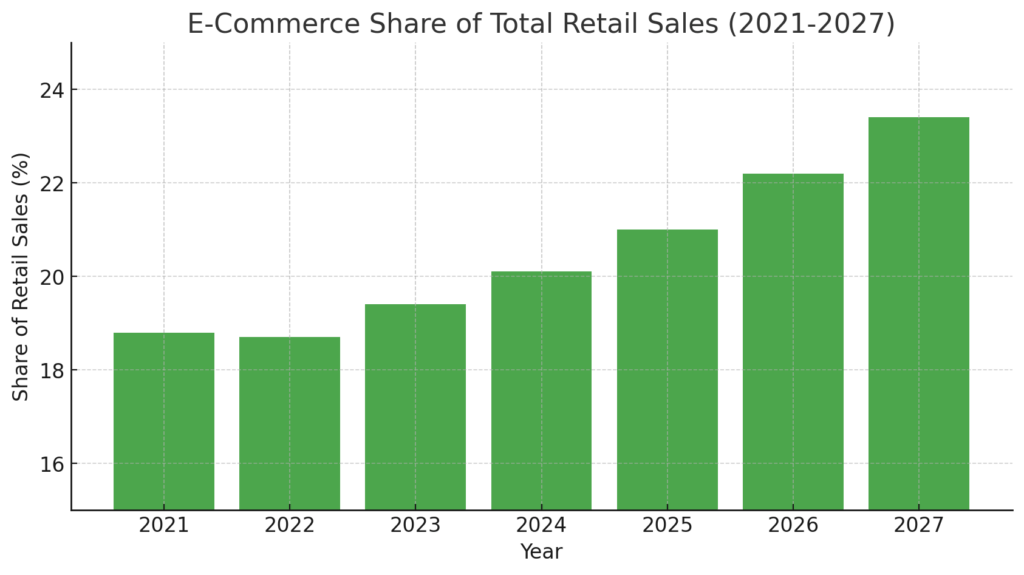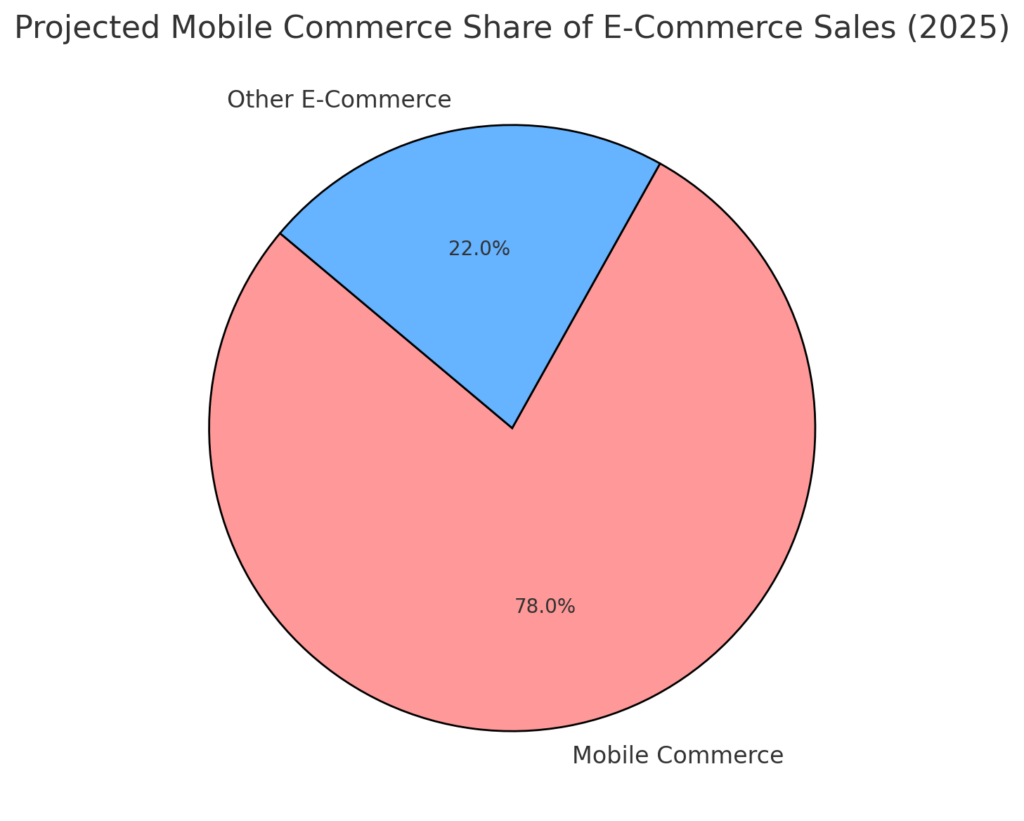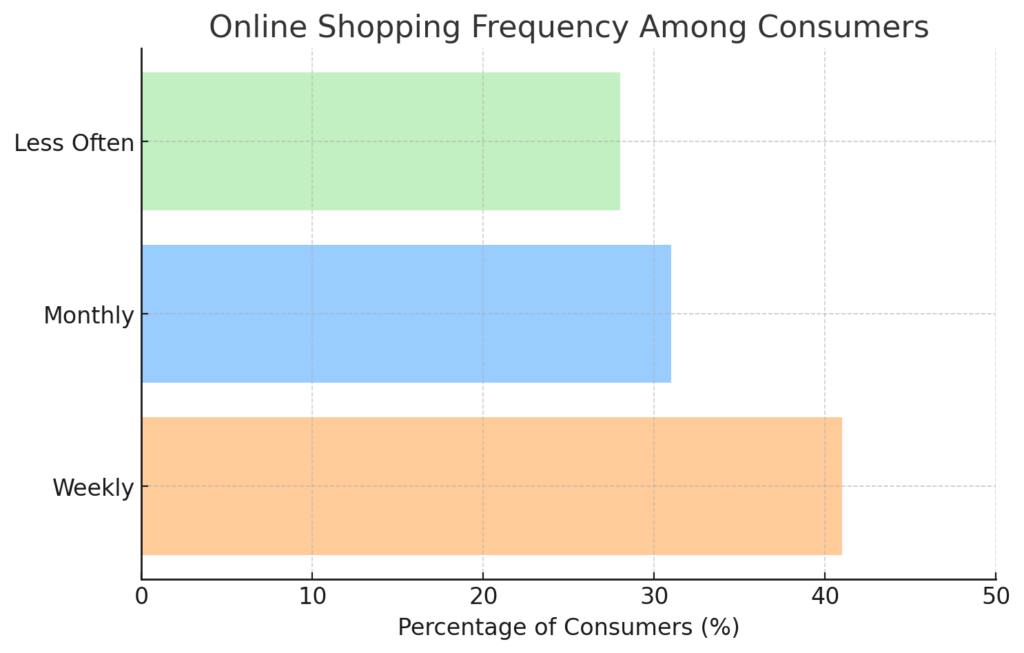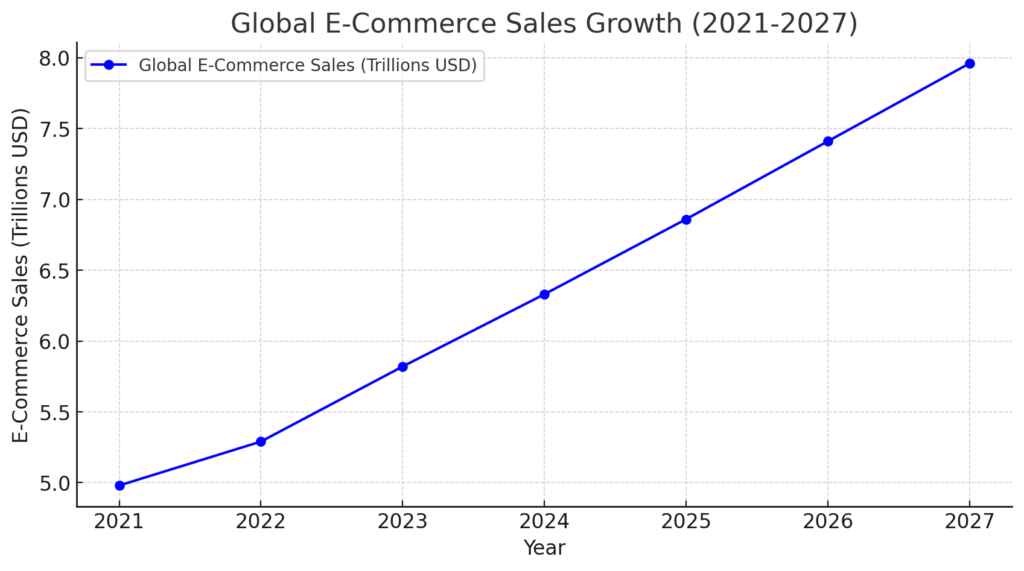
15 Mar BEST ONLINE SHOPPING STATISTICS 2025
Online shopping has evolved from a convenience to an essential part of global commerce, reshaping how consumers interact with brands and make purchasing decisions. As digital transactions continue to rise, emerging technologies, shifting consumer behaviors, and regional trends are shaping the future of e-commerce. The widespread adoption of mobile commerce, social shopping, and AI-driven personalization is accelerating this transformation, forcing businesses to adapt to new expectations. While some markets experience rapid growth, others are facing economic and sustainability challenges that influence spending habits. Understanding these key trends is crucial for businesses looking to remain competitive in an increasingly digital world. Amra and Elma presents the following 20 statistics to provide a comprehensive view of the state of online shopping today and offer valuable insights into where the industry is headed in 2025 and beyond.
BEST ONLINE SHOPPING STATISTICS 2025 (Editor’s Choice)
Online shopping has experienced significant growth over the years, with projections indicating continued expansion in 2025. Here are 20 key statistics highlighting the evolution and future trends of online shopping:
1. Global Online Shoppers: The number of online shoppers worldwide is expected to reach 2.77 billion in 2025, accounting for 33% of the global population.
2. E-commerce Sales Growth: Global retail e-commerce sales are projected to exceed $4.3 trillion in 2025.
3. United States Online Shoppers: The U.S. is anticipated to have nearly 285 million online shoppers by 2025, up from 268 million in 2022.
4. Mobile Commerce: In 2023, 72% of global e-commerce sales were made through mobile devices, with this figure expected to rise to nearly 88% by 2027.
5. Social Media Influence: In a 2023 survey, 58% of U.S. shoppers reported purchasing a product after encountering it on a social media platform.
6. Online Shopping Frequency: Approximately 20% of consumers make online purchases once a week, while 31% shop online once a month.
7. Per Capita Online Spending:
- United States: In 2023, the average annual per capita e-commerce spending was $3,370.
- Europe: Over $1,000.
- Asia: $657.
- Latin America: Approximately $467.
- Africa: Approximately $83.
8. Projected E-commerce Market Size: The global e-commerce market is expected to total $4.8 trillion in 2025, with e-commerce accounting for 23% of total retail sales by 2027.
9. Online Shopping Preferences in the U.S.: 92% of consumers in the U.S. shop online, with 43% preferring online shopping over in-store purchases.
10. E-commerce Growth in India: The number of online shoppers in India is projected to reach 378 million by 2025, accounting for about 24% of the population.
11. Global E-commerce Sales Projection: Global e-commerce retail sales are projected to hit $7.4 trillion in 2025.
12. Mobile Shopping Trends: Mobile commerce sales are expected to reach $728.28 billion by 2025.
13. Voice Commerce: Nearly 40% of U.S. internet users engage with voice assistants like Alexa or Google Assistant for shopping.
14. Online Shopping Frequency in the U.S.: Approximately 41% of Americans shop online weekly.
15. Global E-commerce Penetration: 85% of global consumers shop online.
16. E-commerce in China: China is home to over half of the global e-commerce retail sales.
17. Online Shopping in Europe: 78% of Europeans bought something online in 2023.
18. E-commerce in India: The e-commerce market in India was valued at $147.3 billion in 2024, with an 18.7% compound annual growth rate projected through 2028.
19. Online Shopping in Germany: 99% of German adults now shop online, with 39% doing so weekly.
20. Online Shopping in Australia: The value of the average online order in Australia has dropped by 23% over the past two years, falling to $98.
These statistics underscore the rapid growth and evolving nature of online shopping, highlighting its increasing significance in the global retail landscape

BEST ONLINE SHOPPING STATISTICS 2025 and Future Implications
BEST ONLINE SHOPPING STATISTICS 2025 #1. Global Online Shoppers (2.77 Billion in 2025)
With 2.77 billion people expected to shop online by 2025, e-commerce is solidifying its dominance as the preferred way to shop. This surge means businesses must continuously refine their digital experiences to cater to a more diverse and global audience. Increased accessibility to online shopping, particularly in emerging markets, will fuel demand for localized payment options and multilingual customer support. The rise in online shoppers also necessitates better cybersecurity measures to protect sensitive financial and personal data. Logistics and supply chains will need to be more efficient to meet growing global demand, potentially accelerating innovations in automation and AI-driven inventory management. Sustainability will also become a greater focus, as the environmental impact of e-commerce—such as packaging waste and carbon emissions from deliveries—comes under scrutiny. Companies that embrace personalization, fast shipping, and ethical practices will be well-positioned to thrive in this evolving landscape.
BEST ONLINE SHOPPING STATISTICS 2025 #2. Global Retail E-Commerce Sales ($4.3 Trillion by 2025)
The projected growth of global e-commerce sales to $4.3 trillion by 2025 highlights the industry’s expanding influence on the global economy. As more consumers turn to online shopping, businesses will need to prioritize digital transformation strategies to capture market share. This boom will also drive increased competition, pushing companies to differentiate through superior customer service, product offerings, and seamless digital experiences. Supply chain efficiency will become even more critical, requiring investment in AI-driven logistics and last-mile delivery solutions. The financial implications extend beyond retailers, as governments may introduce new regulations and digital tax policies to capture revenue from online sales. The environmental footprint of e-commerce will also gain more attention, prompting brands to explore sustainable alternatives such as eco-friendly packaging and carbon-neutral shipping. Companies that successfully adapt to these shifts will strengthen their market presence in an increasingly digital-first economy.
BEST ONLINE SHOPPING STATISTICS 2025 #3. United States Online Shoppers (285 Million by 2025)
With an estimated 285 million U.S. consumers shopping online by 2025, nearly the entire adult population will engage in e-commerce. This growth means businesses must provide more personalized and seamless shopping experiences to retain their share of the market. AI and machine learning will play a crucial role in predicting consumer behavior and offering tailored recommendations. Retailers will also need to enhance mobile-first strategies, as more consumers prefer shopping via smartphones over desktops. The competitive landscape will intensify, requiring brands to invest in faster shipping, easy returns, and innovative customer engagement strategies. Increased online shopping will also lead to more demand for cybersecurity and fraud prevention measures as digital transactions become even more common. Companies that focus on user experience, trust, and convenience will stand out in the crowded e-commerce space.
BEST ONLINE SHOPPING STATISTICS 2025 #4. Mobile Commerce Growth (72% of Sales in 2023, Expected to Reach 88% by 2027)
The steady increase in mobile commerce, expected to reach 88% of global e-commerce sales by 2027, highlights the shift toward mobile-first shopping experiences. Retailers must optimize their websites and apps for mobile users, ensuring fast load times, intuitive navigation, and seamless checkout processes. Mobile payment options like Apple Pay, Google Pay, and digital wallets will become standard, replacing traditional payment methods. Social commerce will also play a bigger role, with platforms like Instagram, TikTok, and WhatsApp integrating shopping features directly into their interfaces. The rise of mobile shopping will further drive demand for personalized push notifications and AI-driven chatbots for customer support. Security will be a major concern, as mobile transactions increase the risk of fraud and cyber threats. Businesses that prioritize convenience, security, and personalized engagement will gain a competitive advantage in the mobile commerce era.
BEST ONLINE SHOPPING STATISTICS 2025 #5. Social Media Influence on Purchases (58% of U.S. Shoppers in 2023)
The fact that 58% of U.S. shoppers purchased a product after seeing it on social media highlights the growing impact of influencer marketing and direct-to-consumer (DTC) strategies. Platforms like TikTok, Instagram, and Facebook have evolved beyond entertainment spaces into powerful e-commerce hubs. This shift will drive brands to invest more in social media advertising, live shopping events, and influencer collaborations to boost visibility. Personalized recommendations and AI-driven content curation will enhance user engagement and drive higher conversion rates. Trust and authenticity will be key, as consumers increasingly favor reviews and recommendations from real users over traditional advertising. As social commerce expands, data privacy regulations may tighten, requiring businesses to navigate new policies around targeted advertising. Companies that successfully integrate social media and shopping will be well-positioned to capitalize on this digital retail evolution.

BEST ONLINE SHOPPING STATISTICS 2025 #6. Online Shopping Frequency (20% Shop Weekly, 31% Monthly)
With 20% of consumers shopping online weekly and 31% doing so monthly, e-commerce is becoming a habitual behavior rather than an occasional convenience. Subscription services, loyalty programs, and exclusive online discounts will be essential for businesses looking to convert occasional shoppers into frequent customers. The demand for faster shipping will increase, pushing retailers to adopt same-day or next-day delivery models. Consumers will expect seamless experiences across platforms, whether shopping on mobile apps, websites, or social media. The high frequency of online shopping will also lead to greater expectations around product availability and real-time inventory updates. As shopping habits continue to evolve, businesses will need to leverage AI to analyze consumer behavior and personalize product recommendations. Retailers that successfully engage customers through convenience, personalization, and seamless logistics will secure long-term customer loyalty.
BEST ONLINE SHOPPING STATISTICS 2025 #7. Annual Per Capita Online Spending (U.S. – $3,370, Europe – $1,000, Asia – $657, Latin America – $467, Africa – $83)
The disparity in annual online spending across regions highlights the varying levels of e-commerce adoption worldwide. The U.S. leads with an average spend of $3,370 per person, reflecting a mature e-commerce market with established infrastructure and trust in digital transactions. Europe and Asia show strong growth potential, with businesses focusing on localized shopping experiences to increase spending. Latin America and Africa, while currently lower in per capita spending, present massive opportunities as internet access and digital payment adoption rise. Global brands must tailor their strategies based on regional preferences, ensuring affordable pricing, flexible payment methods, and efficient logistics. Cross-border e-commerce will continue to expand, allowing consumers in lower-spending regions to access a wider range of products. Businesses that adapt to regional differences while maintaining scalability will unlock new revenue streams in emerging markets.
BEST ONLINE SHOPPING STATISTICS 2025 #8. Global E-Commerce Market Size ($4.8 Trillion in 2025, 23% of Retail Sales by 2027)
The anticipated growth of the global e-commerce market to $4.8 trillion by 2025, capturing 23% of total retail sales by 2027, marks a fundamental shift in consumer purchasing behavior. Traditional retail stores will need to adapt by incorporating digital strategies and omnichannel experiences to remain competitive. The role of AI, automation, and predictive analytics will become increasingly critical in optimizing supply chains and personalizing customer interactions. Cross-border trade will expand, requiring businesses to streamline international shipping, payments, and compliance regulations. Additionally, the rise in e-commerce will likely lead to increased regulatory scrutiny on taxation, data privacy, and fair competition. Sustainability concerns will grow, encouraging companies to invest in eco-friendly logistics and packaging solutions. Retailers that embrace digital transformation and align with consumer expectations will continue to thrive in this evolving market.
BEST ONLINE SHOPPING STATISTICS 2025 #9. Online Shopping Preferences in the U.S. (92% of Consumers Shop Online, 43% Prefer It Over In-Store Purchases)
With 92% of U.S. consumers shopping online and 43% preferring it over in-store purchases, the convenience of e-commerce has reshaped retail habits. This shift means traditional brick-and-mortar retailers must adopt omnichannel strategies to integrate online and offline experiences seamlessly. Consumers now expect hybrid shopping options like in-store pickup, same-day delivery, and interactive online product previews. The preference for online shopping also suggests a growing reliance on AI-driven product recommendations, chatbots, and virtual try-on technologies to replicate the in-store experience. Additionally, retailers must focus on creating immersive and engaging digital storefronts, ensuring that websites and apps are visually appealing and easy to navigate. With fewer consumers visiting physical stores, commercial real estate may see a transformation, with more emphasis on experiential retail spaces rather than traditional showrooms. Businesses that effectively bridge the gap between digital and physical retail will maintain customer engagement and loyalty.
BEST ONLINE SHOPPING STATISTICS 2025 #10. E-Commerce Growth in India (378 Million Online Shoppers by 2025)
India’s projected rise to 378 million online shoppers by 2025 highlights the rapid digitalization of one of the world’s largest consumer markets. As internet penetration increases, especially in rural areas, businesses will need to tailor their platforms for mobile-first users. Digital payment adoption will also rise, with a preference for mobile wallets and UPI-based transactions over credit cards. Companies must localize content by offering multilingual support and region-specific promotions to capture diverse consumer segments. The surge in e-commerce also brings challenges in logistics, requiring improved last-mile delivery solutions and partnerships with local courier services. Cross-border e-commerce opportunities will expand as Indian consumers seek international brands, prompting businesses to streamline import regulations and shipping processes. Companies that understand regional preferences and leverage India’s booming digital ecosystem will position themselves for long-term success.

BEST ONLINE SHOPPING STATISTICS 2025 #11. Global E-Commerce Sales Projection ($7.4 Trillion in 2025)
The projected $7.4 trillion in global e-commerce sales by 2025 underscores the industry’s unstoppable growth. This expansion means businesses must scale their infrastructure to handle increased transactions, requiring robust server capabilities and cybersecurity enhancements. The competition among online retailers will intensify, leading to aggressive pricing strategies, personalized offers, and subscription-based models to retain customers. Supply chain innovations will be crucial, as demand for faster shipping times and cost-effective logistics continues to grow. As more consumers shop globally, regulatory frameworks will need to evolve, addressing cross-border taxation, data protection, and fair market competition. Sustainability concerns will escalate, forcing companies to explore carbon-neutral shipping and eco-friendly packaging solutions. The businesses that anticipate these changes and proactively adapt will dominate the future e-commerce landscape.
BEST ONLINE SHOPPING STATISTICS 2025 #12. Mobile Shopping Trends (Projected to Reach $728.28 Billion in 2025)
With mobile commerce sales expected to reach $728.28 billion in 2025, smartphones are becoming the dominant shopping device. Businesses must prioritize mobile optimization, ensuring that their websites and apps are fast, responsive, and easy to navigate. Mobile checkout processes need to be streamlined, integrating digital wallets, biometric authentication, and one-click purchasing to reduce cart abandonment. The rise in mobile shopping also means that app-based loyalty programs and push notifications will become more valuable for customer retention. Augmented reality (AR) features, such as virtual try-ons for fashion and home decor, will enhance mobile shopping experiences. Security will be a major focus, as mobile fraud and data breaches continue to be a concern. Companies that master the mobile shopping experience will benefit from higher conversion rates and stronger customer loyalty.
BEST ONLINE SHOPPING STATISTICS 2025 #13. Voice Commerce (40% of U.S. Consumers Use Voice Assistants for Shopping)
The fact that nearly 40% of U.S. consumers use voice assistants like Alexa and Google Assistant for shopping signals a growing shift toward hands-free commerce. This trend will push retailers to optimize their product listings for voice search, ensuring they appear in results when users make spoken queries. AI-driven recommendations will play a bigger role, as voice assistants learn shopping behaviors and suggest personalized products. Frictionless transactions, including automatic reorders for frequently purchased items, will drive convenience-driven shopping experiences. Brands will also need to invest in conversational AI, making voice interactions more engaging and accurate. Privacy concerns may arise as consumers become more aware of how their voice data is stored and used. Companies that integrate voice commerce seamlessly while addressing security concerns will gain an early advantage in this emerging market.
BEST ONLINE SHOPPING STATISTICS 2025 #14. Online Shopping Frequency in the U.S. (41% Shop Weekly)
With 41% of Americans shopping online weekly, e-commerce is becoming a regular, ingrained behavior rather than an occasional activity. Retailers must ensure their inventory and logistics can handle consistent demand, avoiding stock shortages and delivery delays. Subscription services, automated reordering, and loyalty programs will become increasingly valuable in capturing frequent shoppers. Consumers will expect a seamless experience across multiple devices, from desktops to smartphones to smart home assistants. The high frequency of online shopping may also lead to increased impulse buying, influencing how retailers use real-time promotions and AI-driven suggestions. Sustainability concerns will rise as consumers realize the environmental impact of frequent online purchases, pressuring businesses to adopt greener shipping practices. Companies that align their strategies with convenience, affordability, and sustainability will secure long-term customer retention.
BEST ONLINE SHOPPING STATISTICS 2025 #15. Global E-Commerce Penetration (85% of Consumers Shop Online)
With 85% of global consumers engaging in online shopping, e-commerce is no longer a niche market but a universal retail channel. Businesses must accommodate diverse shopping behaviors across cultures and regions, tailoring marketing strategies accordingly. Payment options will need to be inclusive, supporting alternative methods like digital wallets, cryptocurrencies, and buy-now-pay-later services. The dominance of e-commerce will also lead to new challenges, such as digital fraud, requiring stronger authentication processes and AI-driven fraud detection systems. As shopping habits shift further online, retailers must rethink the role of physical stores, potentially transforming them into experience centers or fulfillment hubs. The impact on employment structures will be significant, with traditional retail jobs evolving toward digital and logistics-focused roles. Companies that recognize and adapt to these sweeping changes will thrive in the digital-first retail landscape.

BEST ONLINE SHOPPING STATISTICS 2025 #16. E-Commerce in China (More Than Half of Global E-Commerce Sales)
China’s dominance in global e-commerce, accounting for over half of worldwide sales, showcases its advanced digital infrastructure and consumer adoption rates. The country’s leadership in mobile payments, live-stream shopping, and super-app ecosystems sets a benchmark for other markets. Western retailers looking to compete must adopt similar strategies, integrating seamless digital experiences with AI-driven personalization. Cross-border e-commerce will expand as Chinese platforms like Alibaba and JD.com facilitate international shopping. Logistics innovations, such as drone deliveries and smart warehouses, will continue to push efficiency in fulfillment operations. Chinese consumer expectations around ultra-fast shipping and interactive shopping experiences will influence global trends. Retailers that keep pace with China’s rapid digital advancements will gain a competitive edge in the global market.
BEST ONLINE SHOPPING STATISTICS 2025 #17. Online Shopping in Europe (78% of Europeans Shop Online)
With 78% of Europeans purchasing online, digital commerce is deeply embedded in the region’s consumer habits. The high penetration rate means businesses must focus on refining the user experience rather than just attracting new shoppers. EU regulations on data privacy, consumer protection, and sustainability will continue to shape how e-commerce operates. Cross-border shopping will grow, requiring retailers to simplify international shipping and currency conversions. Mobile shopping trends will accelerate, particularly in countries with younger digital-native populations. Environmental consciousness is high in Europe, so retailers must prioritize eco-friendly packaging and carbon offset initiatives. Companies that align with European consumers’ digital and ethical expectations will see stronger brand loyalty and long-term growth.
BEST ONLINE SHOPPING STATISTICS 2025 #18. E-Commerce in India ($147.3 Billion Market in 2024, 18.7% Annual Growth Through 2028)
India’s e-commerce market, valued at $147.3 billion in 2024 and growing at 18.7% annually, represents one of the fastest-expanding digital economies. The rise of affordable smartphones and increased internet penetration, particularly in rural areas, is fueling this rapid growth. Payment innovations like UPI (Unified Payments Interface) have made digital transactions more accessible, reducing reliance on cash-based purchases. Local and international brands must focus on localization, offering multilingual support, regional pricing, and logistics solutions tailored to India’s vast geography. The intense competition between global giants like Amazon and local leaders like Flipkart will push innovation in delivery speed, pricing strategies, and customer engagement. Social commerce, driven by WhatsApp, Instagram, and influencer marketing, will play a significant role in India’s e-commerce expansion. Businesses that recognize India’s diverse consumer base and adapt their offerings accordingly will gain a strong foothold in this booming market.
BEST ONLINE SHOPPING STATISTICS 2025 #19. Online Shopping in Germany (99% of Adults Shop Online, 39% Weekly)
With 99% of German adults shopping online and 39% doing so weekly, digital retail has become deeply ingrained in the country’s consumer habits. This near-universal adoption highlights the importance of seamless, secure, and efficient e-commerce experiences. German consumers value quality, transparency, and sustainability, pushing brands to adopt ethical sourcing and eco-friendly packaging practices. The strong preference for data privacy and security means companies must comply with strict GDPR regulations and ensure robust cybersecurity measures. Payment preferences in Germany lean towards bank transfers and invoicing, requiring businesses to offer flexible payment solutions. Logistics efficiency is critical, as customers expect reliable, fast deliveries with easy returns. Companies that align with German consumers’ expectations around quality, sustainability, and data protection will maintain customer loyalty in this highly competitive market.
BEST ONLINE SHOPPING STATISTICS 2025 #20. Online Shopping in Australia (Average Online Order Value Dropped to $98, Down 23% in Two Years)
The decline in Australia’s average online order value to $98, a 23% drop over two years, suggests shifting consumer behaviors amid economic uncertainties. Rising living costs and inflation have made shoppers more price-conscious, favoring budget-friendly products and discounts. Businesses must adapt by offering flexible payment options like buy-now-pay-later services and focusing on value-driven marketing. Free shipping and loyalty programs will play a crucial role in encouraging higher cart values and repeat purchases. The drop in spending also indicates a shift towards necessity-driven shopping rather than impulse buys, requiring brands to refine their product positioning. Local e-commerce growth may be impacted by global supply chain issues, making domestic sourcing and production more attractive for Australian retailers. Companies that cater to changing spending habits while maintaining affordability and convenience will thrive in Australia’s evolving digital retail landscape.
Final Thoughts
These statistics highlight the rapid and ongoing transformation of e-commerce across different regions, technologies, and consumer behaviors. The rise of mobile commerce, social shopping, and AI-driven personalization will continue reshaping how people engage with online retail. While some markets are experiencing exponential growth, others are adjusting to changing economic conditions and sustainability concerns. Businesses that prioritize innovation, security, and localized strategies will thrive in this competitive digital economy. As the retail landscape shifts further online, staying ahead of trends will be crucial for companies aiming to capture and retain customers in an increasingly digital-first world.
Sources:
- https://www.sellerscommerce.com/blog/ecommerce-statistics/
- https://www.statista.com/topics/871/online-shopping/
- https://optinmonster.com/online-shopping-statistics/
- https://inbeat.agency/blog/online-shopping-statistics/
- https://inbeat.agency/blog/online-shopping-statistics/
- https://inbeat.agency/blog/online-shopping-statistics/
- https://inbeat.agency/blog/online-shopping-statistics/
- https://www.shopify.com/enterprise/blog/global-ecommerce-statistics
- https://www.digitalsilk.com/digital-trends/top-online-shopping-statistics/
- https://amzscout.net/blog/online-shopping-statistics/
- https://explodingtopics.com/blog/ecommerce-stats
- https://inbeat.agency/blog/online-shopping-statistics/
- https://www.fastsimon.com/ecommerce-wiki/optimized-ecommerce-experience/fascinating-online-shopping-statistics/
- https://www.fastsimon.com/ecommerce-wiki/optimized-ecommerce-experience/fascinating-online-shopping-statistics/
- https://explodingtopics.com/blog/ecommerce-stats
- https://explodingtopics.com/blog/ecommerce-stats
- https://amzscout.net/blog/online-shopping-statistics/
- https://en.wikipedia.org/wiki/E-commerce_in_India
- https://www.reuters.com/markets/europe/tech-wary-germans-get-hooked-with-online-shopping-habit-2024-11-25/
- https://www.news.com.au/finance/business/retail/aussies-shopping-for-cheaper-items-as-delivery-demands-squeeze-business-margins/news-story/7f48c405f562314f020d684d990e97f5

